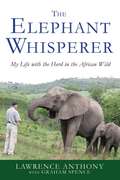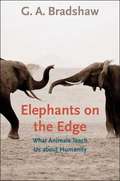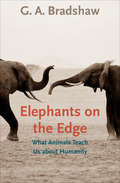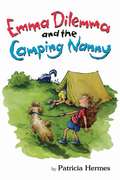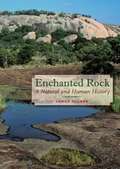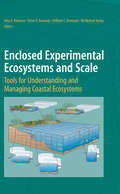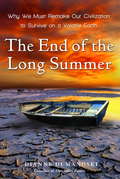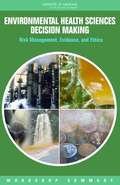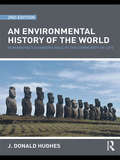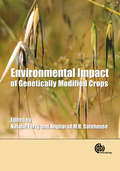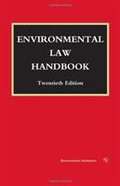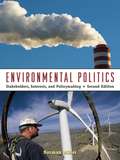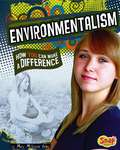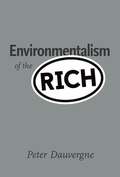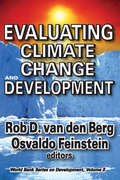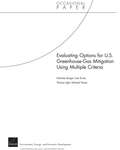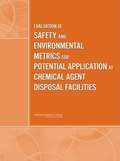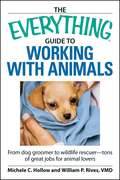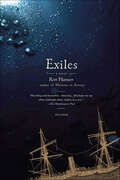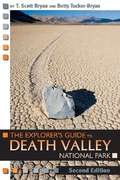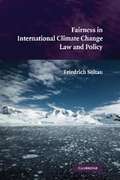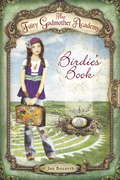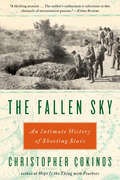- Table View
- List View
The Elephant Whisperer: My Life With the Herd in the African Wild
by Lawrence Anthony Graham SpenceLawrence Anthony devoted his life to animal conservation, protecting the world's endangered species. Then he was asked to accept a herd of "rogue" wild elephants on his Thula Thula game reserve in Zululand. His common sense told him to refuse, but he was the herd's last chance of survival: they would be killed if he wouldn't take them. In order to save their lives, Anthony took them in. In the years that followed he became a part of their family. And as he battled to create a bond with the elephants, he came to realize that they had a great deal to teach him about life, loyalty, and freedom. The Elephant Whispereris a heartwarming, exciting, funny, and sometimes sad memoir of Anthony's experiences with these huge yet sympathetic creatures. Set against the background of life on an African game reserve, with unforgettable characters and exotic wildlife, Anthony's unrelenting efforts at animal protection and his remarkable connection with nature will inspire animal lovers and adventurous souls everywhere.
Elephants on the Edge: What Animals Teach Us about Humanity
by G. A. BradshawDrawing on accounts from India to Africa and California to Tennessee, and on research in neuroscience, psychology, and animal behavior, the author explores the minds, emotions, and lives of elephants.
Elephants on the Edge: What Animals Teach Us about Humanity
by G. A. Bradshaw&“At times sad and at times heartwarming . . . Helps us to understand not only elephants, but all animals, including ourselves&” (Peter Singer, author of Animal Liberation). Drawing on accounts from India to Africa and California to Tennessee, and on research in neuroscience, psychology, and animal behavior, G. A. Bradshaw explores the minds, emotions, and lives of elephants. Wars, starvation, mass culls, poaching, and habitat loss have reduced elephant numbers from more than ten million to a few hundred thousand, leaving orphans bereft of the elders who would normally mentor them. As a consequence, traumatized elephants have become aggressive against people, other animals, and even one another; their behavior is comparable to that of humans who have experienced genocide, other types of violence, and social collapse. By exploring the elephant mind and experience in the wild and in captivity, Bradshaw bears witness to the breakdown of ancient elephant cultures. But, she reminds us, all is not lost. People are working to save elephants by rescuing orphaned infants and rehabilitating adult zoo and circus elephants, using the same principles psychologists apply in treating humans who have survived trauma. Bradshaw urges us to support these and other models of elephant recovery and to solve pressing social and environmental crises affecting all animals—humans included. &“This book opens the door into the soul of the elephant. It will really make you think about our relationship with other animals.&” —Temple Grandin, author of Animals in Translation
Emma Dilemma and the Camping Nanny
by Patricia HermesNine-year-old Emma O'Fallon finds herself in increasing difficulties as her complicated efforts to break up the growing attachment between Annie, the Irish nanny, and Bo, her boyfriend, cause chaos on a family camping trip and her own relationship with her best friend Luisa seems to be going from bad to worse.
Enchanted Rock: A Natural and Human History
by Lance AllredWith intriguing domes of pinkish granite surrounded by a sea of Hill Country limestone, Enchanted Rock State Natural Area attracts over 300,000 visitors every year who come to the park to hike, rock climb, spelunk, camp, picnic, and observe birds and wildflowers. Geologists from around the world come to Enchanted Rock to examine landforms that were shaped by forces on ancient continents of Earth more than one billion years ago! All of these visitors, however, are only the latest comers in a line of human history that stretches back 13,000 years to early Native Americans and includes Spanish explorers, Mexican and German settlers, and thirteen private and public owners up to the current owner, the state of Texas. Surprisingly, given the area's wealth of unusual geology, native plants and animals, and human history, no comprehensive guide to Enchanted Rock has been published before now. In Enchanted Rock, you'll find everything you need to fully appreciate this unique place. Lance Allred draws on the work of specialists in many fields to offer a popular account of the park's history, geology, weather, flora, and fauna. Whether you want to know more about how Enchanted Rock was formed, identify a wildflower or butterfly, or learn more about plant communities along the hiking trails, you'll find accurate information here, presented in an inviting style. Over a thousand color photographs illustrate the enjoyable text.
Enclosed Experimental Ecosystems and Scale
by W. Michael Kemp John E. Petersen William C. Dennison Victor S. KennedyEnclosed ecosystem experiments have gained in popularity as research tools in ecological science, particularly in the study of coastal aquatic environments. These systems provide scientists with a degree of experimental control that is not achievable through field experiments. Yet to date, techniques for systematically extrapolating results from small-scale experimental ecosystems to larger, deeper, more open, more biologically diverse, and more heterogeneous ecosystems in nature have not been well developed. Likewise, researchers have lacked methods for comparing and extrapolating information among natural ecosystems that differ in scale. Enclosed Experimental Ecosystems and Scale: Tools for Understanding and Managing Coastal Ecosystems provides scientists, managers, and policy makers with an introduction to what has been termed the "problem of scale", and presents information that will allow for improved design and interpretation of enclosed experimental aquatic ecosystems. The book integrates the results of a 10-year research project involving a multi-disciplinary team of scientists and students to explore scale-related questions in a variety of coastal habitats. Anticipating use as a reference, the book has been designed so that individual sections and individual pages can function as stand alone units.
The End of the Long Summer: Why We Must Remake Our Civilization to Survive On A Volatile Earth
by Dianne DumanoskiFor the past twelve thousand years, Earth’s stable climate has allowed human civilization to flourish. But this long benign summer is an anomaly in the Earth’s history and one that is rapidly coming to a close. The radical experiment of our modern industrial civilization is now disrupting our planet’s very metabolism; our future hinges in large part on how Earth responds. Climate change is already bearing down, hitting harder and faster than expected. The greatest danger is not extreme yet discrete weather events, such as Hurricane Katrina or the calamitous wildfires that now plague California, but profound and systemic disruptions on a global scale. Contrary to the pervasive belief that climate change will be a gradual escalator ride into balmier temperatures, the Earth’s climate system has a history of radical shifts–dramatic shocks that could lead to the collapse of social and economic systems. The question is no longer simply how can we stop climate change, but how can we as a civilization survive it. The guiding values of modern culture have become dangerously obsolete in this new era. Yet as renowned environmental journalist Dianne Dumanoski shows, little has been done to avert the crisis or to prepare human societies for a time of growing instability. In a work of astonishing scope, Dumanoski deftly weaves history, science, and culture to show how the fundamental doctrines of modern society have impeded our ability to respond to this crisis and have fostered an economic globalization that is only increasing our vulnerability at this critical time. She exposes the fallacy of banking on a last-minute technological fix as well as the perilous trap of believing that humans can succeed in the quest to control nature. Only by restructuring our global civilization based on the principles that have allowed Earth’s life and our ancestors to survive catastrophe——diversity, redundancy, a degree of self-sufficiency, social solidarity, and an aversion to excessive integration——can we restore the flexibility needed to weather the trials ahead. In this powerful and prescient book, Dumanoski moves beyond now-ubiquitous environmental buzzwords about green industries and clean energy to provide a new cultural map through this dangerous passage. Though the message is grave, it is not without hope. Lucid, eloquent, and urgent,The End of the Long Summerdeserves a place alongside transformative works such asSilent SpringandThe Fate of the Earth. From the Hardcover edition.
Environmental Health Sciences Decision Making: Risk Management, Evidence, and Ethics
by Institute of MedicineEnvironmental health decision making can be a complex undertaking, as there is the need to navigate and find balance among three core elements: science, policy, and the needs of the American public. Policy makers often grapple with how to make appropriate decisions when the research is uncertain. The challenge for the policy maker is to make the right decision with the best available data in a transparent process. The Environmental Health Sciences Decision Making workshop, the first in a series, was convened to inform the Roundtable on Environmental Health Sciences, Research, and Medicine on emerging issues in risk management, "weight of evidence," and ethics that influence environmental health decision making. The workshop, summarized in this volume, included an overview of the principles underlying decision making, the role of evidence and challenges for vulnerable populations, and ethical issues of conflict of interest, scientific integrity, and transparency. The workshop engaged science interest groups, industry, government, and the academic sector.
An Environmental History of the World: Humankind's Changing Role in the Community of Life (Routledge Studies In Physical Geography And Environment Ser. #Vol. 2)
by J. Donald HughesThis second edition of An Environmental History of the World continues to present a concise history, from ancient to modern times, of the interactions between human societies and the natural environment, including the other forms of life that inhabit our planet. Throughout their evolutionary history, humans have affected the natural environment, sometimes with a promise of sustainable balance, but also in a destructive manner. This book investigates the ways in which environmental changes, often the result of human actions, have caused historical trends in human societies. This process has happened in every historical period and in every part of the inhabited earth. The book is organized into ten chapters. The main chapters follow a chronological path through the history of mankind, in relationship to ecosystems around the world. The first explains what environmental history is, and argues for its importance in understanding the present state of the world's ecological problems. Chapters two through eight form the core of the historical analysis, each concentrating on a major period of human history (pre-civilized, early civilizations, classical, medieval, early modern, early and later twentieth century, and contemporary) that has been characterized by large-scale changes in the relationship between human societies and the biosphere, and each gives several case studies that illustrate significant patterns occurring at that time. The chapters covering contemporary times discuss the physical impacts of the huge growth in population and technology, and the human responses to these problems. Our moral obligations to nature and how we can achieve a sustainable balance between technology and the environment are also considered. This revised second edition takes account of new research and the course of history containing new sections on global warming, the response of New Orleans to the hurricanes Katrina and Rita, and the experience of the Dutch people in protecting their low-lying lands against the encroachments of rivers, lakes, and the North Sea. New material is also offered on the Pacific Islands, including the famous case of Easter Island. This is an original work that reaches further than other environmental histories. Rather than looking at humans and the environment as separate entities, this book places humans within the community of life. The relationship between environmental thought and actions, and their evolution, is discussed throughout. Little environmental or historical knowledge is assumed from the reader in this introduction to environmental history. We cannot reach a useful understanding of modern environmental problems without the aid of perspective provided by environmental history, with its illustrations of the ways in which past decisions helped or hindered the interaction between nature and culture. This book will be influential and timely to all interested in or researching the world in which we live.
An Environmental History of the World: Humankind's Changing Role in the Community of Life
by J. Donal Hughes J. Donald HughesThis second edition of An Environmental History of the World continues to present a concise history, from ancient to modern times, of the interactions between human societies and the natural environment, including the other forms of life that inhabit our planet. Throughout their evolutionary history, humans have affected the natural environment, sometimes with a promise of sustainable balance, but also in a destructive manner. This book investigates the ways in which environmental changes, often the result of human actions, have caused historical trends in human societies. This process has happened in every historical period and in every part of the inhabited earth. The book is organized into ten chapters. The main chapters follow a chronological path through the history of mankind, in relationship to ecosystems around the world. The first explains what environmental history is, and argues for its importance in understanding the present state of the world's ecological problems. Chapters two through eight form the core of the historical analysis, each concentrating on a major period of human history (pre-civilized, early civilizations, classical, medieval, early modern, early and later twentieth century, and contemporary) that has been characterized by large-scale changes in the relationship between human societies and the biosphere, and each gives several case studies that illustrate significant patterns occurring at that time. The chapters covering contemporary times discuss the physical impacts of the huge growth in population and technology, and the human responses to these problems. Our moral obligations to nature and how we can achieve a sustainable balance between technology and the environment are also considered. This revised second edition takes account of new research and the course of history containing new sections on global warming, the response of New Orleans to the hurricanes Katrina and Rita, and the experience of the Dutch people in protecting their low-lying lands against the encroachments of rivers, lakes, and the North Sea. New material is also offered on the Pacific Islands, including the famous case of Easter Island. This is an original work that reaches further than other environmental histories. Rather than looking at humans and the environment as separate entities, this book places humans within the community of life. The relationship between environmental thought and actions, and their evolution, is discussed throughout. Little environmental or historical knowledge is assumed from the reader in this introduction to environmental history. We cannot reach a useful understanding of modern environmental problems without the aid of perspective provided by environmental history, with its illustrations of the ways in which past decisions helped or hindered the interaction between nature and culture. This book will be influential and timely to all interested in or researching the world in which we live.
Environmental Impact of Genetically Modified Crops
by Angharad M. R. Gatehouse Natalie FerryThe genetic modification of crops continues to be the subject of intense debate, and opinions are often strongly polarised. Environmental Impact of Genetically Modified Crops addresses the major concerns of scientists, policy makers, environmental lobby groups and the general public regarding this controversial issue, from an editorially neutral standpoint. While the main focus is on environmental impact, food safety issues, for both humans and animals are also considered. The book concludes with a discussion on the future of agricultural biotechnology in the context of sustainability, natural resource management and future global population and food supply.
Environmental Law
by Daniel M. Steinway Baker Botts Buchanan Patterson William F. Brownell Karen J. Nardi David R. Case Kevin A. EwingThe environmental field and its regulations have evolved significantly since Congress passed the first environmental law in 1970, and the Environmental Law Handbook, published just three years later, has been indispensable to students and professionals ever since. The authors provide clear and accessible explanations, expert legal insight into new and evolving regulations, and reliable compliance and management guidance.
Environmental Politics: Stakeholders, Interests, and Policymaking
by Norman MillerThe second edition of Environmental Politics: Stakeholders, Interests, and Policymaking shows students that environmental politics is fundamentally a clash of competing stakeholders’ interests, and environmental policy the result of their reconciliation. But developments in environmental policymaking over the past several years have been little short of earthshaking. The text not only marks changes in the formal lawmaking process itself, but covers recent elements reshaping environmental politics, such as: the new environmentally activist posture of business the dramatic shift of policymaking influence from the federal to state and local levels the participation of new actors on the environmental policy stage, most notably the faith community the U-turn of organized labor, from opponent of environmentalists to their collaborator the consolidation of the varying missions of environmental advocacy groups to fight global warming the emergence of science from its historic political neutrality to open advocacy the increasing role of both the media and the judiciary Written by an expert with more than 25 years of "smoke-filled room" experience in environmental policymaking, Environmental Politics: Stakeholders, Interests, and Policymaking gives students an insider's view of how policies are forged. By examining current environmental issues through a stakeholder lens, this book not only provides a unique perspective into how policies are adopted, but also illuminates the transformative power of global warming as a political force.
Environmentalism: How You Can Make a Difference
by Mary Mcintyre ColeyDescribes what environmental activism is and serves as a guide explaining how youth can make change in their world.
Environmentalism of the Rich
by Peter DauvergneOver the last fifty years, environmentalism has emerged as a clear counterforce to the environmental destruction caused by industrialization, colonialism, and globalization. Activists and policymakers have fought hard to make the earth a better place to live. But has the environmental movement actually brought about meaningful progress toward global sustainability? Signs of global "unsustainability" are everywhere, from decreasing biodiversity to scarcity of fresh water to steadily rising greenhouse gas emissions. Meanwhile, as Peter Dauvergne points out in this provocative book, the environmental movement is increasingly dominated by the environmentalism of the rich -- diverted into eco-business, eco-consumption, wilderness preservation, energy efficiency, and recycling. While it's good that, for example, Barbie dolls' packaging no longer depletes Indonesian rainforest, and that Toyota Highlanders are available as hybrids, none of this gets at the source of the current sustainability crisis. More eco-products can just mean more corporate profits, consumption, and waste.Dauvergne examines extraction booms that leave developing countries poor and environmentally devastated -- with the ruination of the South Pacific island of Nauru a case in point; the struggles against consumption inequities of courageous activists like Bruno Manser, who worked with indigenous people to try to save the rainforests of Borneo; and the manufacturing of vast markets for nondurable goods--for example, convincing parents in China that disposable diapers made for healthier and smarter babies.Dauvergne reveals why a global political economy of ever more -- more growth, more sales, more consumption -- is swamping environmental gains. Environmentalism of the rich does little to bring about the sweeping institutional change necessary to make progress toward global sustainability.
Ethical Adaptation to Climate Change
by Allen Thompson Jeremy Bendik-KeymerPredictions about global climate change have produced both stark scenarios of environmental catastrophe and purportedly pragmatic ideas about adaptation. This book takes a different perspective, exploring the idea that the challenge of adapting to global climate change is fundamentally an ethical one, that it is not simply a matter of adapting our infrastructures and economies to mitigate damage but rather of adapting ourselves to realities of a new global climate. The challenge is to restore our conception of humanity--to understand human flourishing in new ways--in an age in which humanity shapes the basic conditions of the global environment. In the face of what we have unintentionally done to Earth's ecology, who shall we become? The contributors examine ways that new realities will require us to revisit and adjust the practice of ecological restoration; the place of ecology in our conception of justice; the form and substance of traditional virtues and vices; and the organizations, scale, and underlying metaphors of important institutions. Topics discussed include historical fidelity in ecological restoration; the application of capability theory to ecology; the questionable ethics of geoengineering; and the cognitive transformation required if we are to "think like a planet. "
Evaluating Climate Change and Development: Volume 9, World Bank Series on Development (World Bank Series On Evaluation And Development Ser. #Vol. 8)
by Osvaldo N. FeinsteinClimate change has become one of the most important global issues of our time, with far-reaching natural, socio-economic, and political effects. To address climate change and development issues from the perspective of evaluation, an international conference was held in Alexandria, Egypt. This book distills the essence of that timely conference, building on the experiences of more than 400 reports and studies presented.Developing countries may be particularly vulnerable to the expected onslaught of higher temperatures, rising sea levels, changing waterfall patterns, and increasing natural disasters. All societies will have to reduce their vulnerability to these changes, and this book describes how vulnerabilities may be addressed in a systematic manner so that governments and local communities may better understand what is happening. Different approaches are also discussed, including the use of human security as a criterion for evaluation as well as ways to deal with risk and uncertainty. Evaluating Climate Change and Development presents a rich variety of methods to assess adaptation through monitoring and evaluation.The volume deals with climate change, development, and evaluation; challenges and lessons learned from evaluations; mitigation of climate change; adaptation to climate change; vulnerability, risks and climate change; and presents a concluding chapter on the road ahead. Collectively the authors offer a set of approaches and techniques for the monitoring and evaluation of climate change.
Evaluating Options for U.S. Greenhouse-Gas Mitigation Using Multiple Criteria
by Liisa Ecola Michael Toman Thomas Light Nicholas BurgerChoosing policy responses to mitigate greenhouse gases (GHGs) is one of the great challenges that the United States faces. It will require balancing cost-effectiveness and other objectives that reflect the institutional and political realities of passing major federal legislation with widespread impacts on U.S. producers and consumers. This paper develops a framework for evaluating U.S. GHG-mitigation policy that balances several criteria.
Evaluation of Safety and Environmental Metrics for Potential Application at Chemical Agent Disposal Facilities
by National Research Council of the National AcademiesBy the end of 2009, more than 60 percent of the global chemical weapons stockpile declared by signatories to the Chemical Weapons Convention will have been destroyed, and of the 184 signatories, only three countries will possess chemical weapons-the United States, Russia, and Libya. In the United States, destruction of the chemical weapons stockpile began in 1990, when Congress mandated that the Army and its contractors destroy the stockpile while ensuring maximum safety for workers, the public, and the environment. The destruction program has proceeded without serious exposure of any worker or member of the public to chemical agents, and risk to the public from a storage incident involving the aging stockpile has been reduced by more than 90 percent from what it was at the time destruction began on Johnston Island and in the continental United States. At this time, safety at chemical agent disposal facilities is far better than the national average for all industries. Even so, the Army and its contractors are desirous of further improvement. To this end, the Chemical Materials Agency (CMA) asked the NRC to assist by reviewing CMA's existing safety and environmental metrics and making recommendations on which additional metrics might be developed to further improve its safety and environmental programs.
The Everything® Guide To Working With Animals
by Michele C. Hollow William P. Rives VmdAnimal acupuncturist. Zoo designer. Wildlife rehabilitator. Working with animals can involve much more than helping at an animal shelter or grooming dogs. There are lots of different jobs out there for people who share a deep concern for the welfare of animals. Authors Michele C. Hollow and Dr. William P. Rives give you the inside scoop on all of them, including: Veterinarian and veterinary technician Zoo worker Animal trainer for movies and TV Beekeeper Guide dog trainer This unique career guide features personal stories from experts in the field, including a large-animal surgeon, a professional dog trainer, an animal behaviorist, and the former president and CEO of the American Society for the Prevention of Cruelty to Animals. This guide gives you everything you need to find a job that fits your animal-loving personality.
Exiles: A Novel
by Ron HansenWith Exiles, Ron Hansen tells the story of a notorious shipwreck that prompted Gerard Manley Hopkins to break years of "elected silence" with an outpouring of dazzling poetry. In December 1875 the steamship Deutschland left Bremen, bound for England and then America. On board were five young nuns who, exiled by Bismarck's laws against Catholic religious orders, were going to begin their lives anew in Missouri. Early one morning, the ship ran aground in the Thames and more than sixty lives were lost—including those of the five nuns. Hopkins was a Jesuit seminarian in Wales, and he was so moved by the news of the shipwreck that he wrote a grand poem about it, his first serious work since abandoning a literary career at Oxford to become a priest. He too would die young, an exile from the literary world. But as Hansen's gorgeously written account of Hopkins's life makes clear, he fulfilled his calling. Combining a thrilling tragedy at sea with the seeming shipwreck of Hopkins's own life, Exiles joins Hansen's Mariette in Ecstasy (called "an astonishingly deft and provocative novel" by The New York Times) as a novel that dramatizes the passionate inner search of religious life and makes it accessible to us in the way that only great art can.
The Explorer's Guide to Death Valley, Second Edition
by Betty Tucker-Bryan T. Scott BryanOriginally published in 1995, soon after Death Valley National Park became the fifty-third park in the U.S. park system, The Explorer's Guide to Death Valley National Park was the first complete guidebook available for this spectacular area. Now in its second edition, this is still the only book that includes all aspects of the park. Much more than just a guidebook, it covers the park's cultural history, botany and zoology, hiking and biking opportunities, and more. Information is provided for all of Death Valley's visitors, from first-time travelers just learning about the area to those who are returning for in-depth explorations. Rewritten, reorganized, and revised, the book includes updated point-to-point logs for every road within and around the park, as well as new maps more accurate than those in any other publication. With extensive input from National Park Service resource management, law enforcement, and interpretive personnel, as well as a thorough bibliography for suggested reading, The Explorer's Guide to Death Valley National Park, Second Edition is the most up-to-date, accurate, and comprehensive guide available for this national treasure.
Fairness in International Climate Change Law and Policy
by Friedrich SoltauThis work analyses fairness and equity dimensions of the climate regime. A central issue in international law and policy is how countries of the world should allocate the burden of addressing global climate change. With the link between human activities and climate change clearly established, and the first impacts of climate change being felt, there is a renewed sense of urgency in addressing the problem. Based on an overview of science and the development of the climate regime to date, this book seeks to identify the elements of a working consensus on fairness principles that could be used to solve the hitherto intractable problem of assigning responsibility for combating climate change. The book demonstrates how an analysis of fairness dimensions of climate change - grounded in practical developments and illustrated with reference to the latest developments - can add value to our understanding of current developments and future options for international climate law and policy.
The Fairy Godmother Academy #1: Birdie's Book
by Jan Bozarth Andrea BurdenWhere do fairy godmothers come from? When Birdie goes to visit her grandmother for the first time, she learns that her grandmother is a fairy godmother--which means Birdie's a fairy godmother too! Trained by fairies in a magical land called Aventurine, human fairy godmothers have been hidden protectors of the world for centuries. Birdie' s family talisman, a singing stone, has been broken, and now only Birdie can use the stone to travel to Aventurine to repair it. When she gets there she meets Kerka, a warrior-like girl who has been sent to help her find the other half of the stone. Will Birdie and Kerka have the knowledge and strength to banish the shadow that has come over both the garden in Aventurine and Birdie's family? One thing's for sure--no one who travels to Aventurine will ever be the same again!For girls who are fans of Harry Potter and have outgrown the Disney Fairies series and the American Girl books, the Fairy Godmother Academy is the perfect series--fantasy books filled with magic and adventure but grounded by contemporary girls and issues.The series boasts an amazing Web site that allows girls to enter the world they visit in the books. There they can do activities both on- and offline, vote for things they'd like to see in the books, and connect with other Fairy Godmother Academy fans.Join the Fairy Godmother Academy!Visit the Web site for games, activities, and networking with friends! www.fairygodmotheracademy.com From the Trade Paperback edition.
The Fallen Sky
by Christopher CokinosIn this acclaimed volume, prizewinning poet and nature writer Christopher Cokinos takes us on an epic journey from Antarctica to outer space, weaving together natural history, memoir, and in-depth profiles of amateur researchers, rogue scientists, and stargazing dreamers to tell the riveting tale of how the study of meteorites became a modern science. .
